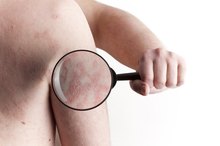What Causes Red Splotches on Facial Skin?
Red, blotchy facial skin is unsightly and can be uncomfortable, depending on the cause of the blotches. When blotches suddenly appear on your face, an allergic reaction or skin condition may be to blame. Your doctor can prescribe an appropriate treatment to clear up red skin blotches and ease any accompanying itching.
Allergic Reactions
Ingredients in food, skin products or clothing can cause allergic reactions that result in red blotches, patches or welts on the skin. Urticaria, commonly called hives, causes itchy red welts that develop when you have a reaction to medication or food. Approximately 10 to 20 percent of the population will have one episode of hives in their lifetime, according to the American Academy of Dermatology.
- Ingredients in food, skin products or clothing can cause allergic reactions that result in red blotches, patches or welts on the skin.
- Urticaria, commonly called hives, causes itchy red welts that develop when you have a reaction to medication or food.
Considerations
Allergies & Redness in the Face
Learn More
You may also notice red blotches and itching if you have contact dermatitis, another skin condition caused by allergies 1. Contact dermatitis causes skin inflammation after your skin is in direct contact with an allergen or irritating substance, such as a detergent, solvent, metal, skin-care product, soap, acid or chemical 1. The condition may also occur after applying topical medication to your face or following exposure to poison ivy. The MedlinePlus online medical reference reports that the allergic reaction is often delayed, with the rash appearing 24 to 48 hours after exposure. An allergy to a particular chemical or substance can develop even if you have safely used the product in the past.
- You may also notice red blotches and itching if you have contact dermatitis, another skin condition caused by allergies 1.
- The condition may also occur after applying topical medication to your face or following exposure to poison ivy.
Rosacea
Rosacea is a skin disease that causes large patches of red skin on the cheeks, forehead, nose and chin. You may also notice tiny spider veins and small bumps that look like pimples. If the disease isn’t treated, eye complications can occur. Untreated rosacea can also result in enlargement of the nose and puffy cheeks. Fair-skinned adults between the ages of 30 to 50 may be at greater risk, according to the American Academy of Dermatology.
- Rosacea is a skin disease that causes large patches of red skin on the cheeks, forehead, nose and chin.
- Untreated rosacea can also result in enlargement of the nose and puffy cheeks.
Weather Effects
How to Get Rid of Psoriasis & Eczema
Learn More
The weather can also play a part in the development of red blotches on your face. If your skin tends to dry out during the winter months, red patches may develop anywhere your skin lacks moisture, including your face. Exposure to windy conditions can also dry the skin and cause red blotches.
Treatment
Doctors prescribe cortisone creams, oral and topical antibiotics and medications containing, metronidazole, retinoids, sulfacatemide and benzoyl peroxide to treat rosacea. Although hives usually disappear on their own, taking an over-the-counter antihistamine can be helpful in relieving itching. In severe cases, your doctor may prescribe cortisone or an injection of epinephrine to relieve symptoms. Treatment of contact dermatitis involves identifying and avoiding the allergen or irritant and applying over-the-counter or prescription-strength corticosteroid ointments or creams 1. Keeping skin moisturized with lotions and creams can help you avoid red blotches due to dry skin.
- Doctors prescribe cortisone creams, oral and topical antibiotics and medications containing, metronidazole, retinoids, sulfacatemide and benzoyl peroxide to treat rosacea.
- In severe cases, your doctor may prescribe cortisone or an injection of epinephrine to relieve symptoms.
Related Articles
References
- MedlinePlus: Contact Dermatitis
- Mayo Clinic: Dry Skin
- Bains SN, Nash P, Fonacier L. Irritant contact dermatitis. Clinical Reviews in Allergy & Immunology. 2018;56(1):99-109. doi:10.1007/s12016-018-8713-0
- Owen JL, Vakharia PP, Silverberg JI. The Role and Diagnosis of Allergic Contact Dermatitis in Patients with Atopic Dermatitis. Am J Clin Dermatol. 2018;19(3):293–302. doi:10.1007/s40257-017-0340-7
- Uter W, Werfel T, White IR, Johansen JD. Contact allergy: A review of current problems from a clinical perspective. Int J Environ Res Public Health. 2018;15(6):1108. doi:10.3390/ijerph15061108
- Robinson M, Visscher M, Laruffa A, Wickett R. Natural moisturizing factors (NMF) in the stratum corneum (SC). I. Effects of lipid extraction and soaking. J Cosmet Sci. 2010;61(1):13-22.
- Cheng J, Zug KA. Fragrance allergic contact dermatitis. Dermatitis. 2014;25(5):232-245. doi:10.1097/der.0000000000000067
- Deza G, Giménez-Arnau AM. Allergic contact dermatitis in preservatives. Current Opinion in Allergy and Clinical Immunology. 2017;17(4):263-268. doi:10.1097/aci.0000000000000373
- Bleasel N, Tate B, Rademaker M. Allergic contact dermatitis following exposure to essential oils. Australasian Journal of Dermatology. 2002;43(3):211-213. doi:10.1046/j.1440-0960.2002.00598.x
- Fransen M, Overgaard LEK, Johansen JD, Thyssen JP. Contact allergy to lanolin: temporal changes in prevalence and association with atopic dermatitis. Contact Dermatitis. 2017;78(1):70-75. doi:10.1111/cod.12872
- Brasch J, Becker D, Aberer W, et al. Guideline contact dermatitis: S1-Guidelines of the German Contact Allergy Group (DKG) of the German Dermatology Society (DDG), the Information Network of Dermatological Clinics (IVDK), the German Society for Allergology and Clinical Immunology (DGAKI), the Working Group for Occupational and Environmental Dermatology (ABD) of the DDG, the Medical Association of German Allergologists (AeDA), the Professional Association of German Dermatologists (BVDD) and the DDG. Allergo J Int. 2014;23(4):126–138. doi:10.1007/s40629-014-0013-5
- Martin SF, Rustemeyer T, Thyssen JP. Recent advances in understanding and managing contact dermatitis. F1000Res. 2018;7:F1000 Faculty Rev-810. doi:10.12688/f1000research.13499.1
- Tan CH, Rasool S, Johnston GA. Contact dermatitis: Allergic and irritant. Clin Dermatol. 2014;32(1):116-124. doi:10.1016/j.clindermatol.2013.05.033
- Verhulst L, Goossens A. Cosmetic components causing contact urticaria: a review and update. Contact Dermatitis. 2016;75(6):333-344. doi:10.1111/cod.12679
Writer Bio
Working at a humane society allowed Jill Leviticus to combine her business management experience with her love of animals. Leviticus has a journalism degree from Lock Haven University, has written for Nonprofit Management Report, Volunteer Management Report and Healthy Pet, and has worked in the healthcare field.









